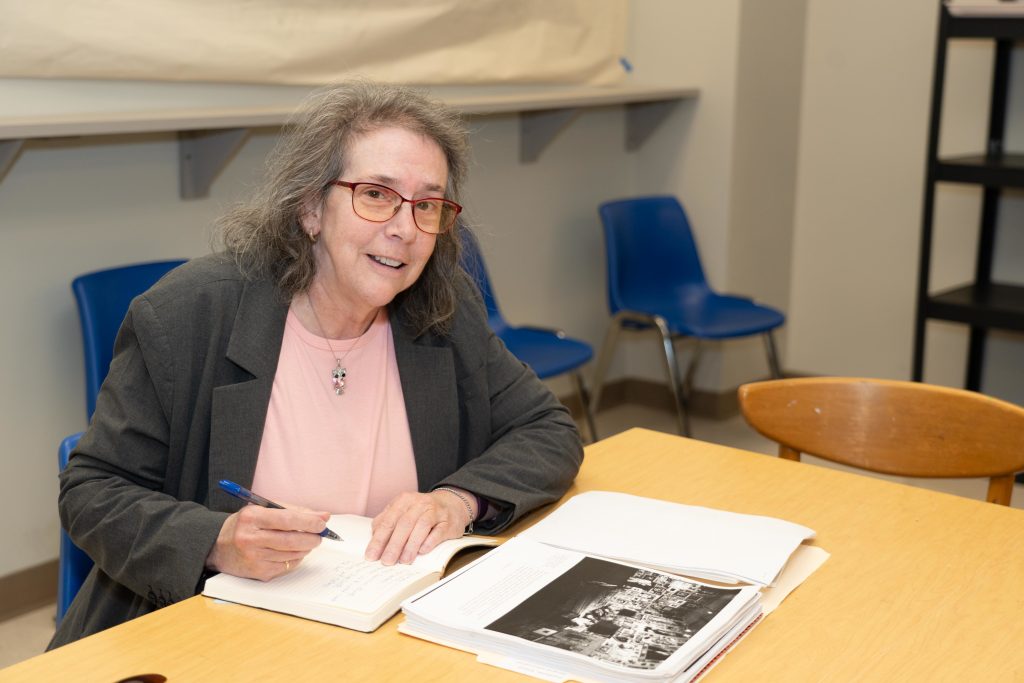Capstone project opens doors internationally for Jefferies
When Sheryl Jefferies set out to begin her capstone project, she had no idea it would take on a life of its own.

Being a transfer, non-traditional student from Shelton State Community College in Tuscaloosa, Alabama, Jefferies had never even heard of The W. But when researching schools to complete her four-year degree, the stars aligned. She found her way to Columbus.
As an interdisciplinary studies major, Jefferies found herself drawn to art history, which would go on to be the basis for her capstone project, a project graduating seniors must complete to earn their degree.
Jefferies struggled with her initial capstone subject, however, a chance encounter shown a light on the path before her.
“For my internship, I worked at the Columbus Arts Council. They had a big Elayne Goodman retrospective. So, I helped with that, and that was actually the first time I’d ever met her. I kind of feel now that I’m the only person who never met her. I met her, and I was kind of blown away by her art. I can remember asking her then, a little more than a year ago, whether she would be interested in sitting down with me and talking to me about her work. I had other things in mind, not necessarily my capstone, but more like The W’s Golden Girls program. Because she was a non-traditional student, she didn’t fit into that particular bucket,” Jefferies said.
Thus was born “Elayne Goodman: Artistic Expression Through Appropriation of Discarded Goods in Deep South Assemblage and Collage Folk Art.”
Goodman is an artist and W alumna who specializes in mixed media pieces using old items such as beads and buttons. Her work has been featured in numerous galleries.
Deciding to take on Goodman as her subject, Jefferies began to notice a trend. There was little information available about local artists that could be utilized by students such as herself. She knew that had to change.
“I feel like what I’ve learned through doing that capstone project is there is very little information out there from this century, in particular, about contemporary local and regional artists. I really had to go digging to find anything even close to what I wanted. So that’s what I’m going to do with the rest of my time on Earth; see to it that that issue is addressed and start providing some primary source information for students who come behind me,” Jefferies said.
Her project was more than successful in earning her a passing grade, ultimately allowing her to graduate in May 2023. However, it did so much more than that.
Before she had even completed work on the project, and at the urging of her adviser Dr. Erin Kempker, Jefferies submitted a proposal to Comité International d’Histoire de l’Art (CIHA). CIHA is an international committee aimed at promoting and improving all facets of art historical research.
Every four years, CIHA holds an international congress, with this year being the 36th one. It will be held in Lyon, France in June.
Jefferies’ work was chosen to be included, and she will represent The W at the congress, a monumental achievement.
“This would be a major honor for a PhD, and Sheryl only recently graduated with her bachelors,” said Dr. Beverly Joyce, professor of Art History and director of galleries at The W.
There was some apprehension for Jefferies though.
“I sent an email to Dr. Kempker and I said, “I found this conference in France, but I don’t have a passport, I don’t speak French, I have no money, and the deadline is only a week away. She got right back to me, and she said, ‘Do it. Don’t worry about anything, just write the proposal. You have a week to get the proposal done, write the proposal.’ Well, the topic was actually different than what I was doing for my capstone, but I could relate to it. So, my capstone was actually on Goodman’s education at The W, but the conference was on using junk as art. I had to switch gears and write a proposal to do a paper on that. It took me almost the whole week, but I did get it done, and I got it sent in. I had no clue, no idea that they would actually approve mine. About a month and a half later, I find out I’m going to France, if I can get the funding.”
That is the major obstacle in her way now. Jefferies is trying every way she knows how to raise the money for the trip.
“I feel weird asking people for money for me to go to France. I feel like it should be sponsored by someone you know. But, you know, it’s not beneath me to beg. So, I mean if some alumni or someone who has a couple extra dollars they don’t need and wants to send it my way, that’d be great,” Jefferies said.
The MUW Foundation contributed to her fundraising efforts as well.
Ultimately, Jefferies hopes to capitalize off her success to continue her work.
“It means a great deal because I’m not a grad student. It means that I have a career, right? It’s a pretty big conference, and they only hold it once every four years. So they’re pretty selective about who they’re getting. … It’s a jumping off point for me, right? From that, and basically from the Capstone, I’m going to be able to do several things. I’m going to be able to submit papers to journals, I’m going to be able to go to other conferences if I can get funding, which is actually turning out to be a big deal, and then I can go on from there, planning to write a couple of books, and this particular topic will be very relevant in both books,” Jefferies said.